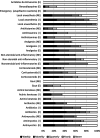Australian podiatrists scheduled medicine prescribing practices and barriers and facilitators to endorsement: a cross-sectional survey
- PMID: 35135610
- PMCID: PMC8822637
- DOI: 10.1186/s13047-022-00515-w
Australian podiatrists scheduled medicine prescribing practices and barriers and facilitators to endorsement: a cross-sectional survey
Abstract
Background: Non-medical prescribing is one healthcare reform strategy that has the potential to create health system savings and offer equitable and timely access to scheduled medicines. Podiatrists are well positioned to create health system efficiencies through prescribing, however, only a small proportion of Australian podiatrists are endorsed to prescribe scheduled medicines. Since scheduled medicines prescribed by Australian podiatrists are not subsidised by the Government, there is a lack of data available on the prescribing practices of Australian podiatrists. The aim of this research was to investigate the prescribing practices among Australian podiatrists and to explore barriers and facilitators that influence participation in endorsement.
Methods: Participants in this quantitative, cross-sectional study were registered and practicing Australian podiatrists who were recruited through a combination of professional networks, social media, and personal contacts. Respondents were invited to complete a customised self-reported online survey, developed using previously published research, research team's expertise, and was piloted with podiatrists. The survey contained three sections: demographic data including clinical experience, questions pertaining to prescribing practices, and barriers and facilitators of the endorsement pathway.
Results: Respondents (n = 225) were predominantly female, aged 25-45, working in the private sector. Approximately one quarter were endorsed (15%) or in training to become endorsed (11%). Of the 168 non-endorsed respondents, 66% reported that they would like to undertake training to become an endorsed prescriber. The most common indications reported for prescribing or recommending medications include nail surgery (71%), foot infections 474 (88%), post-operative pain (67%), and mycosis (95%). The most recommended Schedule 2 medications were ibuprofen, paracetamol, and topical terbinafine. The most prescribed Schedule 4 medicines among endorsed podiatrists included lignocaine (84%), cephalexin (68%), flucloxacillin (68%), and amoxicillin with clavulanic acid (61%).
Conclusion: Podiatrists predominantly prescribe scheduled medicines to assist pain, inflammatory, or infectious conditions. Only a small proportion of scheduled medicines available for prescription by podiatrists with endorsed status were reportedly prescribed. Many barriers exist in the current endorsement for podiatrists, particularly related to training processes, including mentor access and supervised practice opportunities. Suggestions to address these barriers require targeted enabling strategies.
Keywords: Endorsement for scheduled medicine; Podiatry; Prescribing.
© 2022. The Author(s).
Conflict of interest statement
The authors declare they have no competing interests.
Figures



Similar articles
-
Barriers to and facilitators of endorsement for scheduled medicines in podiatry: a qualitative descriptive study.J Foot Ankle Res. 2021 Mar 10;14(1):16. doi: 10.1186/s13047-021-00457-9. J Foot Ankle Res. 2021. PMID: 33691758 Free PMC article.
-
Continuing professional development opportunities for Australian endorsed for scheduled medicines podiatrists-What's out there and is it accessible, relevant, and meaningful? A cross-sectional survey.PLoS One. 2023 Sep 21;18(9):e0289217. doi: 10.1371/journal.pone.0289217. eCollection 2023. PLoS One. 2023. PMID: 37733657 Free PMC article.
-
A survey of foot orthoses prescription habits amongst podiatrists in the UK, Australia and New Zealand.J Foot Ankle Res. 2018 Nov 26;11:64. doi: 10.1186/s13047-018-0304-z. eCollection 2018. J Foot Ankle Res. 2018. PMID: 30505351 Free PMC article.
-
Endorsed midwives prescribing scheduled medicines in Australia: A scoping review.Women Birth. 2024 Mar;37(2):288-295. doi: 10.1016/j.wombi.2023.10.009. Epub 2023 Nov 7. Women Birth. 2024. PMID: 37940475
-
A decade of independent prescribing in the UK: a review of progress.J Foot Ankle Res. 2022 May 11;15(1):35. doi: 10.1186/s13047-022-00541-8. J Foot Ankle Res. 2022. PMID: 35546680 Free PMC article. Review.
Cited by
-
Podiatrists' Reflections on Content and Delivery of Their Pre-Registration Podiatry Programme at a Regional University in New South Wales, Australia: A Survey of Graduates.J Foot Ankle Res. 2025 Sep;18(3):e70053. doi: 10.1002/jfa2.70053. J Foot Ankle Res. 2025. PMID: 40751492 Free PMC article.
References
-
- Duckett S, Breadon PJGIR, September. Access all areas: new solutions for GP shortages in rural Australia 2013.
-
- Nissen L, Kyle G, Stowasser D, Lum E, Jones A, McLean C, et al. Non-medical prescribing: an exploration of likely nature of, and contingencies for, developing a nationally consistent approach to prescribing by non-medical health professionals-final report 1 June 2010. 2010.
-
- Page AT, Cross AJ, Elliott RA, Pond D, Dooley M, Beanland C, et al. Integrate healthcare to provide multidisciplinary consumer-centred medication management: report from a working group formed from the National Stakeholders’ Meeting for the Quality Use of Medicines to Optimise Ageing in Older Australians 2018;48(5):459–46. 10.1002/jppr.1434.
-
- Bennett CJFRotNH, Hospitals reform commission C. National Health and Hospitals Reform Commission: A Healthier Future for All Australians. 2009. - PubMed
MeSH terms
LinkOut - more resources
Full Text Sources

